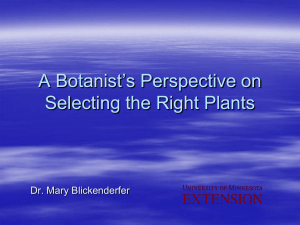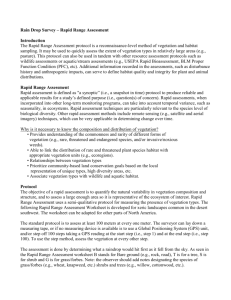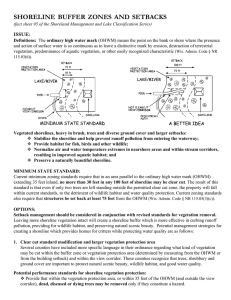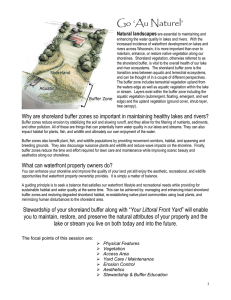SHORE BUFFER AREAS…"WOODSMEN" SPARE THAT TREE! Aquatic Habitat Protection
advertisement
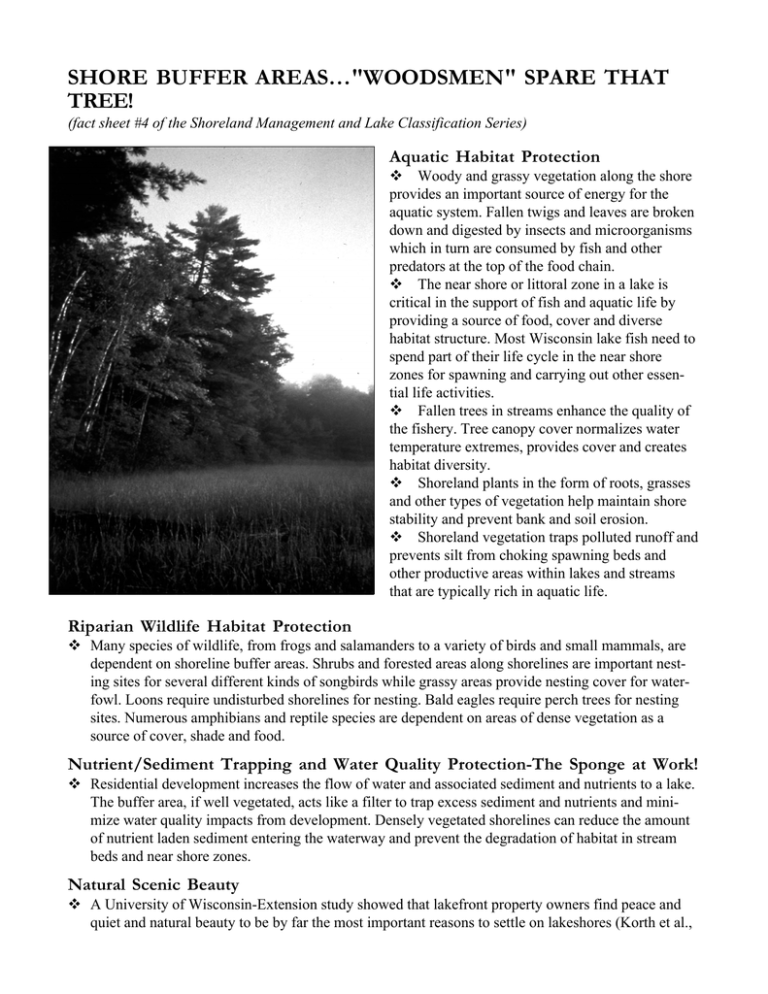
SHORE BUFFER AREAS…"WOODSMEN" SPARE THAT TREE! (fact sheet #4 of the Shoreland Management and Lake Classification Series) Aquatic Habitat Protection ! Woody and grassy vegetation along the shore provides an important source of energy for the aquatic system. Fallen twigs and leaves are broken down and digested by insects and microorganisms which in turn are consumed by fish and other predators at the top of the food chain. ! The near shore or littoral zone in a lake is critical in the support of fish and aquatic life by providing a source of food, cover and diverse habitat structure. Most Wisconsin lake fish need to spend part of their life cycle in the near shore zones for spawning and carrying out other essential life activities. ! Fallen trees in streams enhance the quality of the fishery. Tree canopy cover normalizes water temperature extremes, provides cover and creates habitat diversity. ! Shoreland plants in the form of roots, grasses and other types of vegetation help maintain shore stability and prevent bank and soil erosion. ! Shoreland vegetation traps polluted runoff and prevents silt from choking spawning beds and other productive areas within lakes and streams that are typically rich in aquatic life. Riparian Wildlife Habitat Protection ! Many species of wildlife, from frogs and salamanders to a variety of birds and small mammals, are dependent on shoreline buffer areas. Shrubs and forested areas along shorelines are important nesting sites for several different kinds of songbirds while grassy areas provide nesting cover for waterfowl. Loons require undisturbed shorelines for nesting. Bald eagles require perch trees for nesting sites. Numerous amphibians and reptile species are dependent on areas of dense vegetation as a source of cover, shade and food. Nutrient/Sediment Trapping and Water Quality Protection-The Sponge at Work! ! Residential development increases the flow of water and associated sediment and nutrients to a lake. The buffer area, if well vegetated, acts like a filter to trap excess sediment and nutrients and minimize water quality impacts from development. Densely vegetated shorelines can reduce the amount of nutrient laden sediment entering the waterway and prevent the degradation of habitat in stream beds and near shore zones. Natural Scenic Beauty ! A University of Wisconsin-Extension study showed that lakefront property owners find peace and quiet and natural beauty to be by far the most important reasons to settle on lakeshores (Korth et al., 1994). Shoreland zoning standards are designed to maintain natural scenic beauty by mandating a 75 foot setback and by limiting a property owner’s ability to clearcut to a 30 foot wide view corridor. A community may enhance the view of a natural shoreline and minimize the visibility of shoreline structures by managing building density and by imposing vegetative protection standards. How To Preserve and Restore That Buffer Several factors (buffer size, soil type, and dominant vegetation) combine to form a buffer zone which is effective protection against runoff pollution while serving a variety of habitat needs. Consider these factors when developing a new lakeshore property or restoring existing property: ! Buffer Quality Vegetation type is important for water quality protection and wildlife habitat. Mowed lawns are less effective than natural vegetation in trapping nutrients, intercepting runoff, and preventing bank erosion. Flat stemmed turf grasses bend during runoff and are not effective sediment traps. Mowed lawns are often a significant source of nitrogen and phosphorus because of excessive fertilizer and pesticide applications and provide little habitat diversity for wildlife. A natural mix of ground cover, shrubs and trees trap sediment more effectively than manicured lawns. Many native species have square, triangular or round stems (mint, sedge and reed families) and remain erect during rainstorms and persist throughout the winter to slow spring runoff and trap sediments and nutrients. Shorelines and nearshore zones which consist of a mix of vegetation types, from terrestrial to emergent and submergent vegetation, are likely to accommodate a host of fish and wildlife needs throughout the year. Current vegetation cutting standards, which prohibit clearcutting outside of a view corridor, may still result in the removal of most shoreline plant cover. Shrubbery, trees (young, dead and dying), undergrowth and groundcover provide nesting and feeding sites, protection from predators and important structural complexity (see fact sheet #5 for suggestions on vegetation protection standards). ! Buffer Size There is evidence to suggest that current shoreland zoning standards mandating a 75 foot setback and 35 foot buffer zone may be insufficient to fully protect against erosion and nutrient loading even when most vegetation is intact. The width of a 75 foot zone in terms of providing wildlife habitat is sufficient primarily for edge-adapted species while larger buffers provide greater benefit to wildlife (see fact sheet # 5 for setback management strategies.) References and Additional Sources of Assistance: Korth, R., M. Dresen, and D. Snyder. 1994. Lake Tides survey. Wisconsin Lakes Partnership, University of WisconsinExtension, Stevens Point. Dresen, M. 1995. Shorelandscaping. A guide for waterfront property owners. Wisconsin Lakes Partnership, University of Wisconsin-Extension, Stevens Point. Bernthal, T.W., Barret, J.R. (ed). 1997. Effectiveness of Shoreland Zoning Standards to Meet Statutory Objectives: A Literature Review with Policy Implications. Wisconsin Department of Natural Resources, Madison. Drafted by Tamara Dudiak, UWEX-Lake Specialist (715/346-4744); tdudiak@uwsp.edu. For more information, contact your regional Department of Natural Resources lake coordinator, the Wisconsin Association of Lakes [800/542-5253] or UWEX/UWStevens Point [715/346-2116]. DS/LAKECLASS/FS-4.PM5






